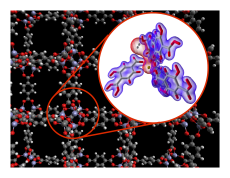New Methodology for Simulating Nanoporous Materials

Large scale simulations were used to study the interaction between H2 and the metal organic framework utilizing new quantum embedding methodology. Image: Jason D. Goodpaster, University of Minnesota.
Science Achievement
Researchers at the Nanoporous Materials Genome Center (NMGC) at the University of Minnesota have developed new molecular simulation methodology that allows for the highly accurate computation of material properties for a fraction of the computational cost. This new methodology can calculate the adsorption energies of small molecules in nanoporous materials such as zeolites and metal-organic frameworks (MOFs). Thanks to large benchmarking simulations run on NERSC supercomputers, the team was able to validate the new methodology for hydrogen adsorption.
Impact
Nanoporous materials allow for gas separation and storage by the tuning of molecular interactions with gas molecules. With millions of hypothetical materials computationally cheap yet accurate methodologies are required to determine which materials should be synthesized and used for gas separation and storage. This new methodology will open the door to high-throughput nanoporoous materials screening.
Research Details
The researchers constructed a quantum embedding methodology based on a multiphysics approach that combined wave function and density functional theory. Wave function theories provide highly accurate calculations of molecular interactions; however, these methods are computationally costly. Therefore, multiphysics approaches have been developed in which one region of the system, such as the gas molecule adsorption site, is treated at the wave function level of theory and the rest of the system is treated at a computationally cheaper level of theory.
The team used NERSC resources to run wave function calculations on large systems to benchmark their quantum embedding methodology. Using a highly parallelized code, they could utilize up to 2048 Cori Nodes (over 135,000 cores) simultaneously to allow for computationally expensive wave function calculations on large systems. They then benchmarked the quantum embedding calculations against these expensive calculations to demonstrate that they could reproduce the full wave function calculations to within 1 kcal/mol at less than 1% of the computational cost.
Related Links
Absolutely Localized Projection-Based Embedding for Excited States
About NERSC and Berkeley Lab
The National Energy Research Scientific Computing Center (NERSC) is a U.S. Department of Energy Office of Science User Facility that serves as the primary high performance computing center for scientific research sponsored by the Office of Science. Located at Lawrence Berkeley National Laboratory, NERSC serves almost 10,000 scientists at national laboratories and universities researching a wide range of problems in climate, fusion energy, materials science, physics, chemistry, computational biology, and other disciplines. Berkeley Lab is a DOE national laboratory located in Berkeley, California. It conducts unclassified scientific research and is managed by the University of California for the U.S. Department of Energy. »Learn more about computing sciences at Berkeley Lab.







